SYS/BIOS简介
创建一个SYS/BIOS项目
在项目模板中选择SYS/BIOS项目中的Hello Example模板,点击Next:

在RTSC(XDCtools的别称)配置页中选中需要的SYS/BIOS,XDCtools及其他组件的版本,Target保持默认,不需修改,如果Platform没有自动填充,选择与设备适用的平台。Build-profile决定程序链接的库,推荐使用release,即使仍然处于创建和调试阶段,点击Finish完成创建项目。
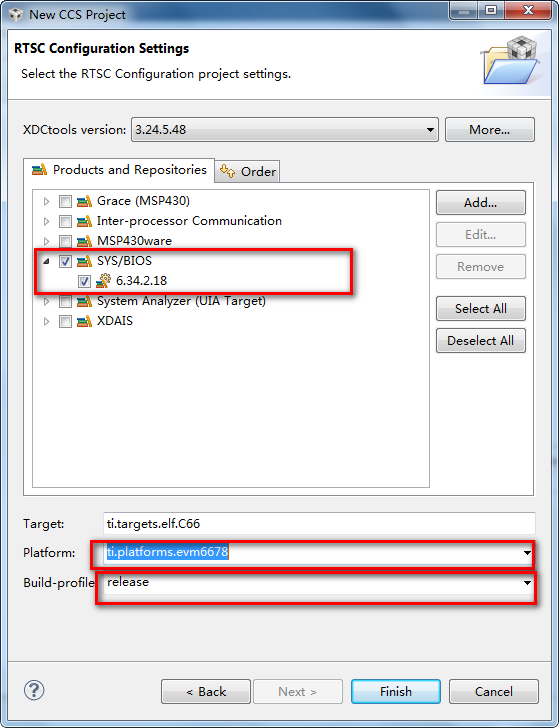
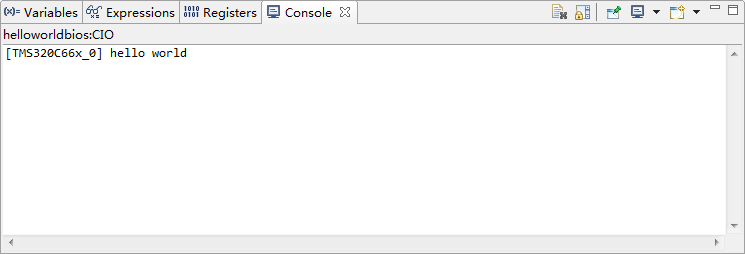
SYS/BIOS的模块与配置
SYS/BIOS可以用文本编辑器或者是图像配置编辑器XGCONF来编辑,双击打开.cfg文件:
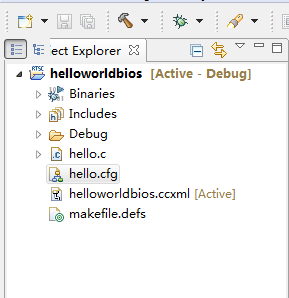
单击System Overview,可以显示程序当前使用的主模块(带绿色小箭头的):
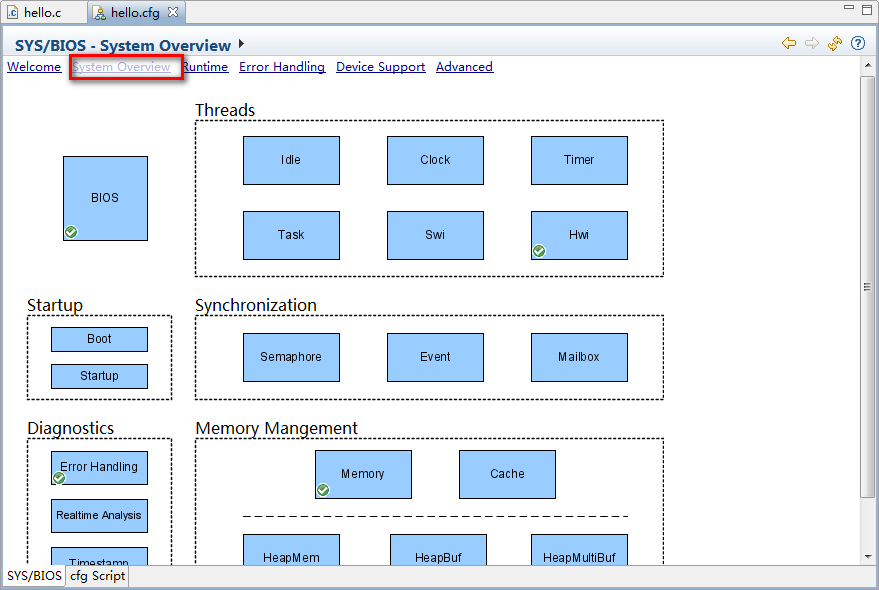
各种APIs模块的添加这里有两种方法,一种是直接双击主模板进入,然后勾选Add:
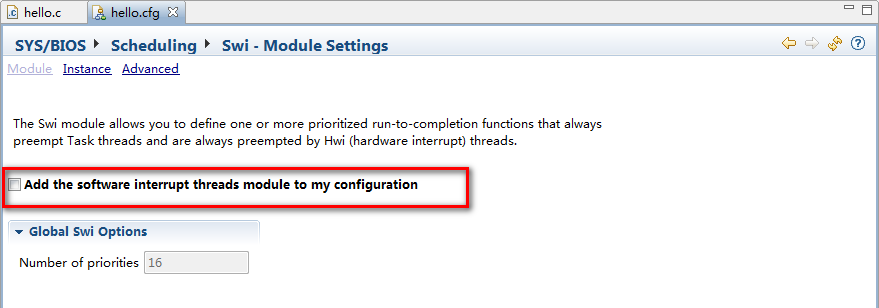
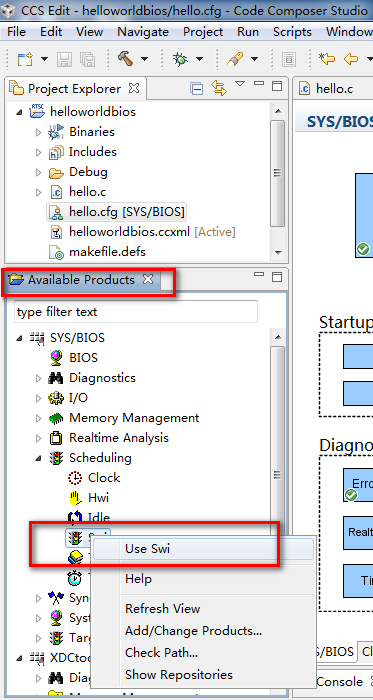
各个API模块的作用
在项目中导入LOG模块
LOG模块实际上是一个实现打印信息的API。
添加LOG模块,默认是自动添加的。
LOG模块定义了许多比如Log_error、Log_info、Log_warning、Log_print等之类函数,这些函数的用法同printf函数的用法很相似,这些函数都可以在<xdc/runtime/Log.h>找到,其实际上是将printf的有用法分成许多不同的类(如错误信息、提示信息、警告信息等),LOG模块打印的内容查看:
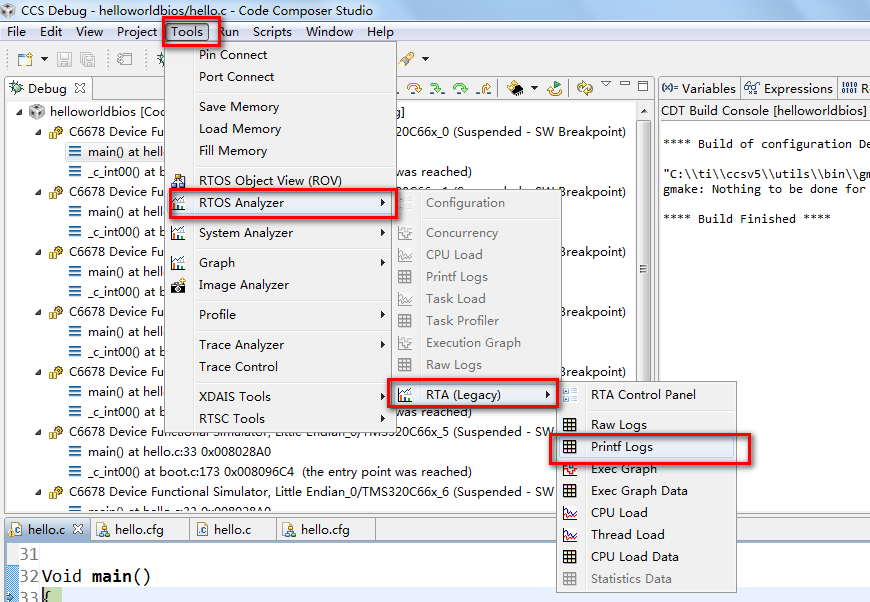
右下角会出现面板:

LOG中定义了许多如下的函数,比如Log_info1函数后面的数字代表函数接的变量数目,如:
Log_info1("%d",s1); Log_info2("%d, %d", s1, s2)
在项目中导入TSK任务模块
TSK任务模块是操作系统中最基本的模块,其实际上反映了多线程抢占,每个任务单独是一个线程,各个线程(任务)具有各自的优先级。
创建新任务,我们创建两个任务task0、task1,分别对应其函数func_tsk0、func_tsk1。其优先级都为1:
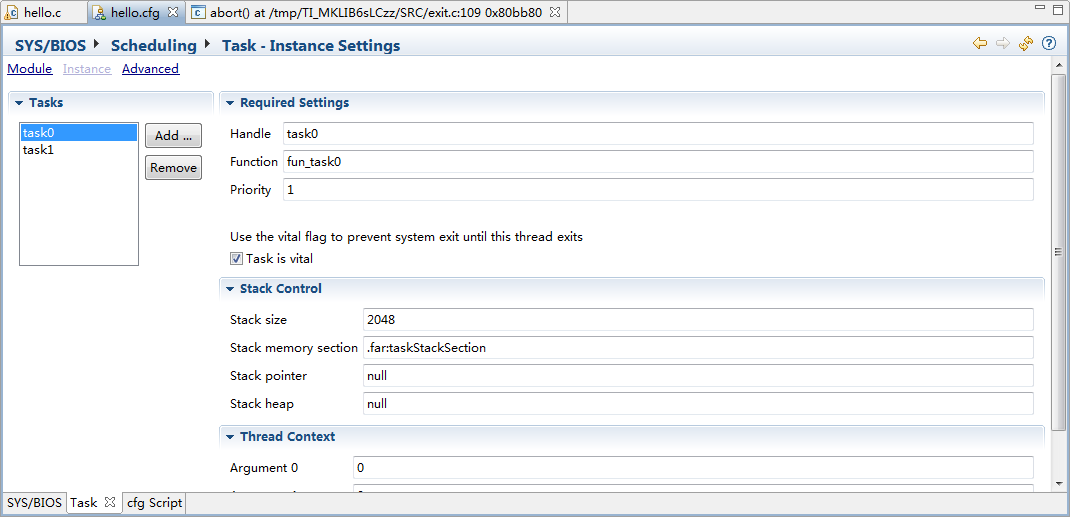
编写任务函数:
/*
* ======== hello.c ========
* The hello example serves as a basic sanity check program for SYS/BIOS. It
* demonstrates how to print the string "hello world" to stdout.
*/
#include <xdc/std.h>
#include <xdc/runtime/System.h>
#include <ti/sysbios/BIOS.h>
#include <xdc/runtime/Log.h>
#include <ti/sysbios/knl/Task.h>
/*
* ======== main ========
*/
void fun_task0(void);
void fun_task1(void);
Void main()
{
System_printf("hello world
");
BIOS_start();
}
void fun_task0(void)
{
Int count = 0;
while(count<10)
{
Log_info1("Task0 is doing %d
",count);
Task_yield();
count++;
}
BIOS_exit(0);
}
void fun_task1(void)
{
Int count = 0;
while(count<10)
{
Log_info1("Task1 is doing %d
",count);
Task_yield();
count++;
}
BIOS_exit(0);
}
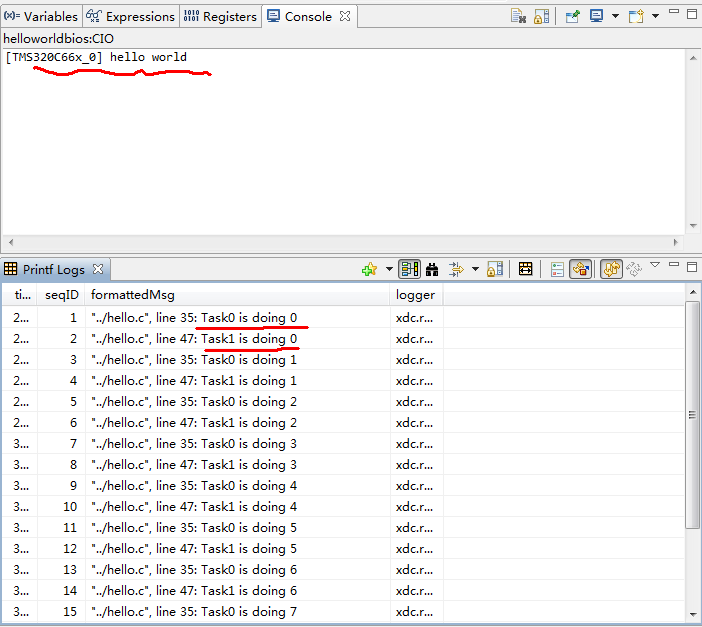
我们可以看到两个任务是相互依次运行的,每个任务运行一次后,其优先级就会降低,此时就切换到下一个任务。
在项目中导入Swi软件中断模块
不同任务有不同优先级,而软件中断具有比任何任务都高的优先级,而其中硬件中断(HWI)又比软件中断(SWI)优先级更高。
添加软件中断Swi:

代码:
/*
* ======== hello.c ========
* The hello example serves as a basic sanity check program for SYS/BIOS. It
* demonstrates how to print the string "hello world" to stdout.
*/
#include <xdc/std.h>
#include <xdc/runtime/System.h>
#include <ti/sysbios/BIOS.h>
#include <xdc/runtime/Log.h>
#include <ti/sysbios/knl/Task.h>
#include <ti/sysbios/knl/Swi.h>
/*
* ======== main ========
*/
void fun_task0(void);
void fun_task1(void);
void func_swi0(void);
Swi_Handle swi0; //声明一个全局的SWI句柄
Void main()
{
System_printf("hello world
");
//初始化SWI参数
Swi_Params swiParams;
Swi_Params_init(&swiParams);
swiParams.priority = 2; //软件中断优先级设置为2
swiParams.trigger = 2; //设置软件中断计数器
swi0 = Swi_create(func_swi0, &swiParams, NULL); //创建软件中断swi0,func_swi0为软件中断函数
BIOS_start();
}
void func_swi0(void)
{
static Int count = 0;
Log_info1("Swi0 is doing %d
",count);
count++;
}
/*更改软件中断计数器trigger,要触发软件中断,首先需要让trigger的计数为0,
这里我们可以在任务函数内增加一个trigger自减的函数,任务函数执行两次后,将会触发软件中断*/
void fun_task0(void)
{
Int count = 0;
while(count<10)
{
Log_info1("Task0 is doing %d
",count);
Swi_dec(swi0);
Task_yield();
count++;
}
BIOS_exit(0);
}
void fun_task1(void)
{
Int count = 0;
while(count<10)
{
Log_info1("Task1 is doing %d
",count);
Swi_dec(swi0);
Task_yield();
count++;
}
BIOS_exit(0);
}
编译调试,运行查看结果(这里我们只需要选择单核运行就可以了):
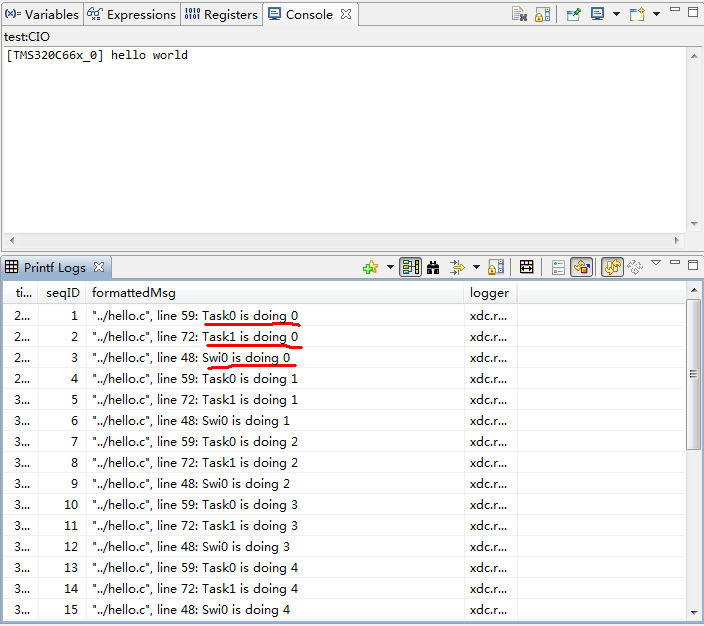
可以看到两个任务的每次都会使得软件中断计数trigger减1(通过Swi_dec函数),直到trigger的值减少到0时,执行软件中断,中断后,trigger恢复到原来的值,这里的trigger初始值为2,所以执行两次任务后就会触发一次软件中断。
在项目中导入信号量Semaphore模块

代码:
/*
* ======== hello.c ========
* The hello example serves as a basic sanity check program for SYS/BIOS. It
* demonstrates how to print the string "hello world" to stdout.
*/
#include <xdc/std.h>
#include <xdc/runtime/System.h>
#include <ti/sysbios/BIOS.h>
#include <xdc/runtime/Log.h>
#include <ti/sysbios/knl/Task.h>
#include <ti/sysbios/knl/Swi.h>
#include <ti/sysbios/knl/Semaphore.h>
/*
* ======== main ========
*/
void fun_task0(void);
void fun_task1(void);
void func_swi0(void);
Swi_Handle swi0;
Semaphore_Handle sem0; //添加全局的信号量句柄
Void main()
{
System_printf("hello world
");
Swi_Params swiParams;
Swi_Params_init(&swiParams);
swiParams.priority = 2;
swiParams.trigger = 2;
swi0 = Swi_create(func_swi0, &swiParams, NULL);
sem0 = Semaphore_create(0, NULL, NULL);//创建信号量
BIOS_start();
}
void func_swi0(void)
{
static Int count = 0;
Log_info1("Swi0 is doing %d
",count);
count++;
//增加一个解锁信号量的函数
Semaphore_post(sem0);
}
void fun_task0(void)
{
Int count = 0;
while(count<10)
{
Semaphore_pend(sem0, BIOS_WAIT_FOREVER);//在增加互斥信号量的任务函数中增加一个等待信号量为1的函数
Log_info1("Task0 is doing %d
",count);
Swi_dec(swi0);
Task_yield();
count++;
}
BIOS_exit(0);
}
void fun_task1(void)
{
Int count = 0;
while(count<10)
{
Log_info1("Task1 is doing %d
",count);
Swi_dec(swi0);
Task_yield();
count++;
}
BIOS_exit(0);
}
编译调试,运行查看结果(这里我们只需要选择单核运行就可以了):

可以看到只有当软件中断执行后,此时信号量才解锁,task0才能执行,而任务执行两次,才能触发一次软件中断。
在项目中导入时钟Clock模块
Clocks模块主要提供周期性执行函数,我们这里新建一个周期性执行函数,其每四个周期执行一次.
添加时钟:
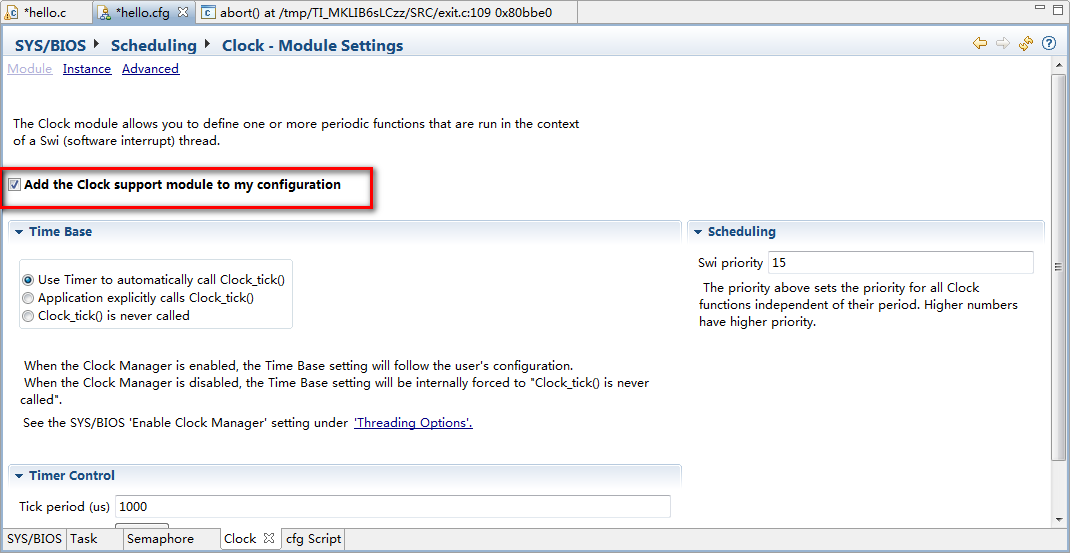
代码:
/*
* ======== hello.c ========
* The hello example serves as a basic sanity check program for SYS/BIOS. It
* demonstrates how to print the string "hello world" to stdout.
*/
#include <xdc/std.h>
#include <xdc/runtime/System.h>
#include <ti/sysbios/BIOS.h>
#include <xdc/runtime/Log.h>
#include <ti/sysbios/knl/Task.h>
#include <ti/sysbios/knl/Swi.h>
#include <ti/sysbios/knl/Semaphore.h>
#include <ti/sysbios/knl/Clock.h>
/*
* ======== main ========
*/
void fun_task0(void);
void fun_task1(void);
void func_swi0(void);
void func_clk(UArg arg0);
Swi_Handle swi0;
Semaphore_Handle sem0;
Void main()
{
System_printf("hello world
");
Swi_Params swiParams;
Swi_Params_init(&swiParams);
swiParams.priority = 2;
swiParams.trigger = 2;
swi0 = Swi_create(func_swi0, &swiParams, NULL);
Clock_Params clkParams;
Clock_Params_init(&clkParams);
clkParams.period = 5; // 函数执行周期
clkParams.startFlag = TRUE; // True说明时钟立即开始计时
Clock_create(func_clk, 5, &clkParams, NULL); //创建时钟,func_clk是周期执行的函数,这里5是开始执行的延时。
sem0 = Semaphore_create(0, NULL, NULL);
BIOS_start();
}
void func_swi0(void)
{
static Int count = 0;
Log_info1("Swi0 is doing %d
",count);
count++;
Semaphore_post(sem0);
}
void func_clk(UArg arg0)
{
UInt32 time;
time = Clock_getTicks(); // 这里是定时器的节拍器
System_printf("System time in clk0Fxn = %lu
", (ULong)time);
if(time>20)
BIOS_exit(0);
}
/*
因为任务的执行时间非常快,所以需要先把任务内的退出BIOS命令先删除下,否则当任务完成后,时钟函数还没执行
*/
void fun_task0(void)
{
Int count = 0;
while(1)
{
Semaphore_pend(sem0, BIOS_WAIT_FOREVER);
Log_info1("Task0 is doing %d
",count);
Swi_dec(swi0);
Task_yield();
count++;
}
}
void fun_task1(void)
{
Int count = 0;
while(1)
{
Log_info1("Task1 is doing %d
",count);
Swi_dec(swi0);
Task_yield();
count++;
}
}
编译调试,运行查看结果(这里我们只需要选择单核运行就可以了):
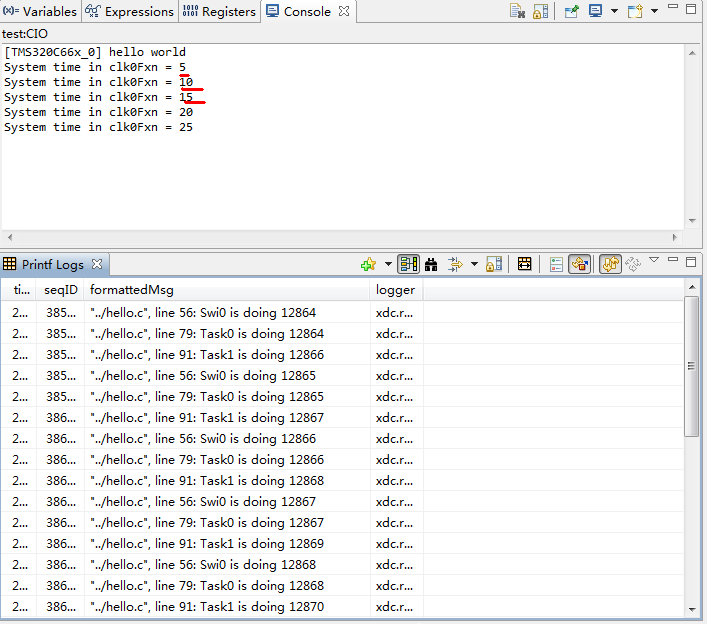
可以看到只有当周期函数func_clk每隔5个周期开始执行,开始执行时间为5。